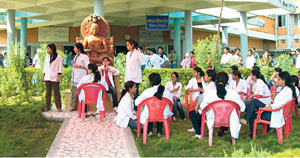Higher graduate enrolment increases in western Nepal's medical studies

Nepalgunj: After being unable able to continue with her higher studies for 15 years, Bheri Zonal Hospital’s nurse Anjana Subedi is more than happy now that she’s her pursing Bachelor’s in Nursing (BN).
Preoccupied with raising her children and keeping her job, the 38-year-old couldn’t move out of Nepalgunj to continue her studies. Now she’s in her final year of her BN studies.
“My wish to continue with BN after I completed my staff nurse studies has finally been fulfilled,” she shared.
Subedi’s long awaited wish to study could only be realized after a college catering to Bachelor in Nursing was established two years ago in Nepalgunj.
Many nurses like Subedi are now studying at Bheri Nursing College. With only 40 seats, most BN students are nurses from government and private hospitals.
“I wasn’t able to continue my studies due to my responsibilities at home and work,” said BN student Sunita Shrestha. “Only now I have the opportunity to get my degree.”
For many years, many in west Nepal were deprived of pursing their graduate degree studies due to the lack of technical courses at the graduate level. It’s only recently that those who want to pursue studies in Graduate and Master’s streams in technical courses are able to do so locally.
The number of students in the college is increasing every year.
Now that Nepalgunj Medical College and Kailpal Hospital and College have commenced classes for Medical Science students at Graduate and Master’s levels, the number of technically specialized human resource has increased.
Since it started MBBS classes in 1997, 954 doctors have graduated from Nepalgunj Medical College. Starting its first batch with 75 students, the college now produces 150 students each year.
“A minimum of 300 students who have passed Nepal Medical Council’s (NMC) examinations compete for 150 seats each year here,” said Dr Suresh Kumar Kanaudiya, Managing Director of Nepalgunj Medical College.
The college also started Master’s level classes in MS/MD from 2007. The postgraduate level, which started with only four students in the MS/MD class in Nepalgunj Medical College, now takes in 20 students each year.
“Though students are now increasing in the MS/MD classes, medical colleges are still not able to take in more students which Nepal really needs,” added Kanaudiya.
Though Nepal produces on average 2,000 MBBS graduates from its eight private and three government medical colleges, only around 500 students get admitted to MS/MD classes, he said.
Despite the fact that the number of students at Graduate and Master’s levels has risen in the previous year in the mid- and far-west regions of Nepal, the present rewuirements haven’t been properly addressed.
“The public needs specialized treatments and services today,” stated Kanaudiya.
Six medical colleges are affiliated to Kathmandu University and two colleges with Tribhuvan University. But the eight medical colleges haven’t been given the green light by the Medical Council and the respective universities to conduct the MS/MD classes according to the colleges’ carrying capacities, he added.
source:republica,4 Sept 2012
Posted on: 2012-09-04































